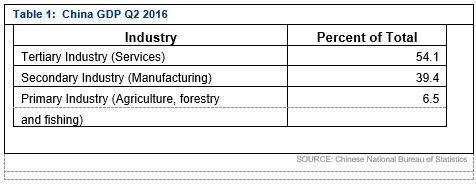We are regularly told that the Chinese economy is slowing down. We are regularly told that this is to Australia's disadvantage. In fact, what is actually happening is that as the Chinese economy slows, it is undergoing significant structural change. This structural change is to Australia's advantage because it generates an increase in Chinese demand for the sort of things that Australia sells. This is particularly true of resources.
Chinese National Accounts for the year to the June quarter shows that the Chinese economy grew by 6.7% year on year. Primary industries or Agriculture, Forestry and Fishing grew by 3.1%. The secondary industry or manufacturing grew by 6.1%. Tertiary industry or Services grew by 7.5%. GDP growth rate appears to have bottomed out in the first quarter. GDP for the second quarter rose by 1.8% after achieving a growth rate of only 1.2% in the first quarter.
As Chinese growth stabilises, the composition of the economy is changing from being primarily manufacturing to primarily services. In Table 1 below, we see that tertiary industry (or services) now comprises 54.1% of the economy. This is now significantly larger than the manufacturing sector which however still provides 39.4% of the economy. Agriculture, forestry and fishing now provide only 6.5% of the economy.
Advertisement
The national accounts release published by the China National Bureau of Statistics (NBS) speaks of efforts to cut over capacity, reduce inventory, deleverage and lower costs in the manufacturing sector. The Chinese government appears to be reducing production by inefficient State owned enterprises. They note that the output of domestically produced coal fell by 9.7% year on year. The output of domestically produced crude steel fell by 1.1%.
Increased Resource Imports
The advantage of reducing inefficient domestic production is you can buy the same product more cheaply on the international market. The result is that Chinese imports of bulk commodities increased. China NBS notes that in the first half of the year, China imported 494 million tonnes of iron ore. This was an increase of 9.1%. China also imported 187 million tonnes of crude oil. This was an increase of 14.2%. China further imported 108 million tonnes of coal, an increase of 8.2%. Very interestingly, China also imported 2.74 million tonnes of copper. This was a whopping increase of 22%.

Investment
Chinese growth is supported by continuing investment. China NBS notes that growth in investment in fixed assets was up by 9% in nominal terms. The cost of this investment fell slightly so that the real increase in fixed investment was 11.1%. Most of this investment was from the public sector. State holding enterprises lifted their investment by 23.5%. Private investment rose by 2.8%. Still, the private sector provided 61.5% of total investment.
Advertisement
There was a big lift in investment in the primary industry. My guess is that this is about increasing infrastructure to support a higher level of pig production. This means feed grain handling as well as animal handling. Demand for pork is a continual problem in China and pork prices regularly feature as an issue in headline inflation.
Investment in secondary industry was up by 4.4%. This again shows the governments interest in rationalising manufacturing production. Investment in tertiary industry or services rose by 11.7%.
Total investment in real estate development rose by 6.1% in nominal terms for the year to the June quarter. Again, given that the factors of production actually fell slightly in price, real growth in real estate development was up by 8%. Investment in residential buildings went up by 5.6%.
There was a surge in floor space of residential building commencement. These rose by 14%. There was a strong surge in existing home sales. These rose by 44.4%. The floor space of commercial residential building sold was up by 27.9%.
Conclusion
Chinese growth has stabilised at 6.7% in the June quarter. As growth stabilises, restructuring of the Chinese economy is allowing China to reduce non-productive and inefficient parts of its manufacturing and mining sector. This is to Australia's benefit. The first half of the year have seen significant increases in Chinese imports of iron ore, crude oil, coal and copper.
We are continually told that we should be frightened of the China slowdown. If this is what slowdown is like, we wish they had done it earlier.
The information contained in this report is provided to you by Morgans Financial Limited as general advice only, and is made without consideration of an individual’s relevant personal circumstances. Morgans Financial Limited ABN 49 010 669 726, its related bodies corporate, directors and officers, employees, authorised representatives and agents (“Morgans”) do not accept any liability for any loss or damage arising from or in connection with any action taken or not taken on the basis of information contained in this report, or for any errors or omissions contained within. It is recommended that any persons who wish to act upon this report consult with their Morgans investment adviser before doing so. Those acting upon such information without advice do so entirely at their own risk.
This report was prepared as private communication to clients of Morgans and is not intended for public circulation, publication or for use by any third party. The contents of this report may not be reproduced in whole or in part without the prior written consent of Morgans. While this report is based on information from sources which Morgans believes are reliable, its accuracy and completeness cannot be guaranteed. Any opinions expressed reflect Morgans judgement at this date and are subject to change. Morgans is under no obligation to provide revised assessments in the event of changed circumstances. This report does not constitute an offer or invitation to purchase any securities and should not be relied upon in connection with any contract or commitment whatsoever
Discuss in our Forums
See what other readers are saying about this article!
Click here to read & post comments.
3 posts so far.